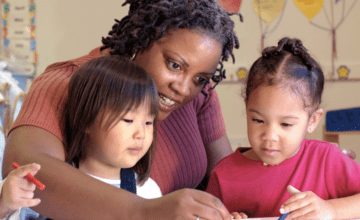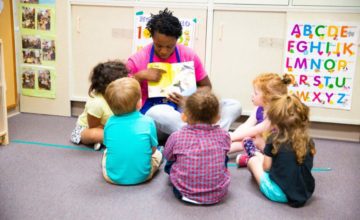Learn how infants and toddlers develop play skills from birth to 3, and what toys and activities are appropriate for their age.
SHARE
Your baby began exploring his world during his first 6 months. But he’s not done exploring—he’s just getting started! Now his explorations become more intentional as his growing language, thinking, and physical skills allow him to do more than he could before. What does this mean? More opportunities for play, making connections, and learning! Read about what happens—and how you can support his development.
Repetition, Repetition—and More Repetition!
While repeating actions over and over again is not necessarily thrilling for parents, babies at this age love it! Repetition helps babies learn new skills. Repeating an activity also helps babies understand cause and effect, the idea that a specific action leads to a specific response.
TOYS TO EXPLORE:
- Toys that encourage repetition like rattles, musical instruments, busy-boxes, blocks
HELPING YOUR BABY PLAY AND LEARN:
- Give your baby a chance to figure out how a toy works. Let her discover that if she pushes the button, a character will pop out of the busy box. Provide just enough support to help her learn. If she can’t press the button hard enough, place your hand on top of hers to help, instead of doing it for her.
- Let your baby repeat fun activities. If your baby knocks your block tower down, build another. Keep this back-and-forth play going until your baby loses interest.
Perfecting the Pincer
The “pincer” grasp is using the pointer finger and thumb to pick up very small objects, like a piece of cereal. This takes a lot of muscle coordination in the fingers! But it allows babies to begin picking up smaller objects. Babies also begin pointing—which is their way of asking questions (by pointing to a dog to say, “What’s that?”) or requesting items (by pointing to a bottle).
TOYS TO EXPLORE:
- Baby-safe, cube-shaped blocks
- Simple puzzles with knobs
- A toy designed to be pulled (such as a rolling toy dog with string to pull)
HELPING YOUR BABY PLAY AND LEARN:
- Lay the string for a pull-toy in front of your child and see if he will pick it up using his fingers and thumb. If he doesn’t, pull the string yourself and then lay it down again and wait. See if he will try. This game is a chance to practice his pincer grasp.
- Read board books together. Let your child try to turn the pages. Choose some touch-and-feel books that invite exploration with her hands and fingers.
What Does This Do? How Does This Work?
Play and exploration go together. For example, when babies play with a ring stack or shape-sorter, they’re learning about the relationships between objects of different sizes and shapes. They’re learning which objects go together when they fill-and-dump. They’re solving problems through trial and error when they turn the crank and the jack-in-the-box pops up.
TOYS TO EXPLORE:
- Busy box or jack-in-the-box
- Simple shape-sorter
- Wooden or foam blocks and bucket for filling and dumping
- Ring stack or stacking cups
HELPING YOUR BABY PLAY AND LEARN:
- Show your baby how to combine objects in his play—like putting blocks in a bucket or banging two blocks together. This helps him move beyond exploring only the look and feel of objects, and figure out how objects go together.
- Offer your baby a ring stack, stacking cups, or a busy box to figure out. You may need to model how to use these toys at first. Then watch your child try to “solve the problem” the toy presents.
Rolling and Crawling and Cruising, Oh My!
It’s a whole new world for babies as they roll, sit up, crawl, pull up, cruise along furniture, and sometimes begin to walk. These new physical skills, while perhaps unnerving for you, are exciting for your baby because they offer freedom to try new ways of moving and playing. This active play takes up much of their waking hours—so don’t be surprised if you see changes in your baby’s sleeping patterns, such as more night-time wake-ups, while he is working on these new physical skills.
TOYS TO EXPLORE:
- Toys that can be pushed and pulled—chunky car/truck, toy vacuum, etc.
HELPING YOUR BABY PLAY AND LEARN:
- Create a child-safe area in your home where your child can explore safely. Put an interesting toy on a low table or on the sofa as a motivation to pull up and reach it.
- When your baby is cruising along the sofa, place a sturdy chair just a few inches away. Your child will move between them by holding on. When he develops more balance, move the chair a few inches away so he has to let go briefly to reach it.
Having Fun With Sounds and Language
Even before babies can say their first words, they connect with you in back-and-forth “conversation.” So when you talk with your baby, give her a turn to respond. She may make a sound, change her facial expression, move her body (such as kicking her legs), or do all of them at the same time. Soon she’ll begin to squeal, laugh, or babble back at you. It’s okay to babble back!
TRY:
- Board books, “finger plays,” songs, and rhymes
HELPING YOUR BABY PLAY AND LEARN:
- “Translate” your baby’s sounds into the words you think he might mean. If he smiles and waves his arms when you sing “The Itsy Bitsy Spider,” say,” You love the spider song! Let’s do it again.” This lets your child know you understand him.
- Make a book that shows photos of your family, pets, home, and your child’s favorite toys. Read the book with your child, naming each photo, to help her learn the names of the people and places in her world.



